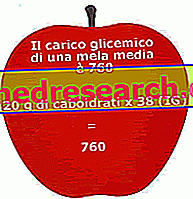The Glycemic Load
The glycemic load ( GL ) is an index that in addition to representing the quality of carbohydrates (IG) also considers their quantity. So a pound of pasta that contains about 74 grams of carbohydrates with a medium glycemic index will increase the blood sugar level more than a banana that has a higher glycemic index but contains less carbohydrates.
And again, fructose has a very low glycemic index (IG = 20) but 50 g of fructose cause a greater glycemic increase than 10 g of sugar (IG = 66).
A trivial example that gives an idea of the difference between index and glycemic load is that of lead and brick.

Calculation of Glycemic Load
The glycemic load is obtained by multiplying the amount of carbohydrates expressed in grams by the glycemic index.
That's why 50 grams of fructose increase the blood sugar level more than 10 grams of
FRUCTOSE GLYCEMIC LOAD GL = 20 * 50g = 1000
SUGAR GLYCEMIC LOAD GL = 66 * 10g = 660
where 20 and 66 indicate, respectively, the glycemic index of fructose and sugar.
Benefits of low index foods and glycemic load
Consuming many foods with a high glycemic load increases the risk of developing type 2 diabetes and many other pathological phenomena.
On the contrary, FOODS WITH LOW GLYCEMIC LOADS CAN PREVENT OBESITY, DIABETES, INSULIN RESISTANCE, AND THE APPEARANCE OF HYPOGLYCAEMIA.
The intake of foods with a high index and glycemic load causes a sharp increase in the concentration of glucose in the blood. Since the glycaemia must remain within a constant range of values (between 70 and 120 mg / dl), the glycemic peak is followed by a rapid release of insulin. This hormone produced by the pancreas facilitates the passage of glucose from the bloodstream to tissue cells, affecting the metabolism. However, the cells are not able to rapidly metabolize large amounts of glucose; for this reason excess sugars are deposited in the form of glucidic (glycogen) or lipid reserves (increase in adipose tissue).
The harmful effects of a diet rich in carbohydrates with a high glycemic index do not end there. An excess of insulin causes a sharp drop in blood sugar (reactive hypoglycemia). Since this parameter MUST remain constant to satisfy the energy requirements of the various organs (in particular of the brain), this sudden decrease is interpreted as a stress signal. The hypothalamic centers capture the need for sugar and elaborate a series of signals that stimulate the sense of hunger.
If the individual, taken by the appetite, takes on high-index foods and glycemic loads again, the process starts again from the beginning, entering a vicious circle that is very harmful to health and silhouette.



